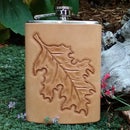Introduction: Rhubarb Leaf Birdbath
My rhubarb plant is out of control! The leaves are big enough to hide a small child under and it's crowding out tomatoes that I value way more than the rhubarb. So I put the gigantic leaves to good use and made a concrete birdbath using them to add texture and interest. The actual truth is, I had an old rhubarb leaf birdbath I made years ago (still good), but it was on the small side and I recently purchased a little solar floating fountain thing that needed a deeper pool to float in. So regardless of how I got to this point, I now have a bigger, deeper, great looking birdbath AND my old one that has found a new home in the garden.
If you don't have rhubarb leaves, you can use any others, you'll just need more of them. Or you could use something else just to add texture to the inside of your birdbath: burlap, wrinkly fabric, ???...
Step 1: Supplies
- bag of sand/topping mix
- mold form-I used a garbage can lid -you can use sand or soil
- drywall tape
- leaves
- wheelbarrow or large bucket to mix concrete
- rubber gloves
Step 2: Prep Your Materials
Get all your materials gathered and organized because once you begin with the wet concrete you will have limited time to work and you don't want it to begin drying before you are finished getting your birdbath shaped.
My can lid had two recessed areas that I packed some potting soil into to keep the convex shape. Depending on your form, you may need to do something like this. You can also make a mound of damp sand or soil and work on top of that. I didn't have sand and I wanted to get a vertical edge on my birdbath, the lid was perfect. My lid did compress under the weight of the concrete, it ended up giving me a flatter bottom to my birdbath, which was fine, but I could have put some bricks or something under the lid to prevent this.
Turns out even my biggest rhubarb leaf was not large enough to cover the entire lid, so I use one giant leaf and two smaller leaves. The place at the base of the leaf, where it connects to the stalk is really thick, so I trimmed all the leaves a bit to eliminate this chunky part.
Step 3: Arrange Your Leaves
Place your leaves stem side up (you want to get all that good texture on the surface of the concave part of your birdbath-you are working inside out at this point). Be sure to have them extend to the edge (or beyond) of your form.
Step 4: Mix Your Concrete
I used a bit less than half the bag of concrete mix for this birdbath and I had a little left over. I think it's better to have too much than run out during the process.
Mix the concrete according to the instructions, you want it to be thick enough to hold a blob in your hand, not runny and wet, nor dry and crumbly.
Start applying it in handfuls to the back of your leaves, after you get about an inch thickness, place the drywall tape pieces in a crisscross pattern over the surface (sorry no pictures, just couldn't do it all at the same time!). Then put another layer of concrete over the tape. This will reinforce the concrete.
Be sure to sort of slap the concrete down, this will ensure that you pick up the texture of the leaves and gets rid of voids on the surface of them.
If you want to make the top surface flat (creating a flat bottom to rest on) this is the time to do that.
Since my form was sitting in the sun all day, I covered it loosely with a piece of damp burlap.
Step 5: The Next Day...
When I looked under the burlap the next morning I found a thin crack running along one edge of the surface. I mixed up a little concrete (a bit wetter than before) and patched over the crack, smoothing out the surface. I recovered it with the burlap and left it to dry for another day.
On the following morning, all seemed hard and without cracks. I lifted the birdbath off the lid and set it back down. Some of the leaves were easy to pull off, the rest I left to dry up on their own. I also snapped off some of the poky bits of concrete along the edge. It still has a rough edge, but I like it that way.
I left it out to further cure another day.
Step 6: The Next, Next Day...
Pulling the leaves out of the cement is a strangely satisfying thing...
If you leave the leaves in the concrete they will eventually disintegrate. Best to let the stubborn bits dry up so you can get them out before filling with water. Rhubarb leaves contain oxalic acid that is harmful to all of us if ingested.
I put the birdbath up on the old oak stump and returned all the rocks and things that I like to have around the birdbath to their spots and filled it with water. Since my birdbath is convex on the bottom I did put a couple of rocks under it to keep it level and so it wouldn't rock.
It holds a nice amount of water, the fountain works and I think it looks great.
I always put a bit of copper wire in the water, it helps to keep the algae at bay.

Participated in the
Backyard Contest












